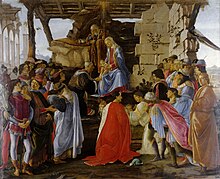The examples and perspective in this article deal primarily with Western culture and do not represent a worldwide view of the subject. (February 2017) |

Self-insertion is a literary device in which the author writes themselves into the story under the guise of, or from the perspective of, a fictional character.[1] The character, overtly or otherwise, behaves like, has the personality of, and may even be described as physically resembling the author of the work.
In visual art, the equivalent of self-insertion is the inserted self-portrait, where the artist includes a self-portrait in a painting of a narrative subject. This has been a common artistic device since at least the European Renaissance.
Among professional writers, the intentional, deliberate use of first-person and third-person self-insertion techniques are commonly considered to be an unoriginal action on the author's part, and represents a paucity of creative thought in his writing.[2][3]
- ^ "Self-insertion meaning". Retrieved 20 February 2022.
- ^ "I Love When Women TV Writers Write Themselves Hot Love Interests". Jezebel. 17 February 2023.
- ^ ""Triggering" Manhattan: The Ethics of Self-Insertion – Confluence". 28 October 2021.
© MMXXIII Rich X Search. We shall prevail. All rights reserved. Rich X Search
